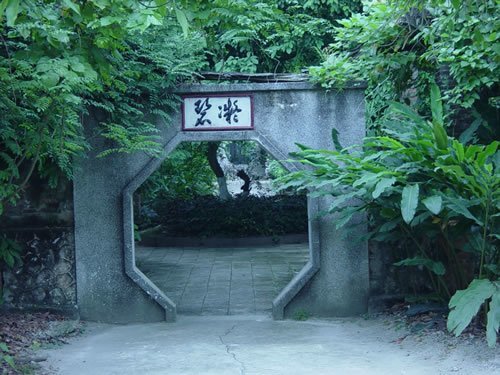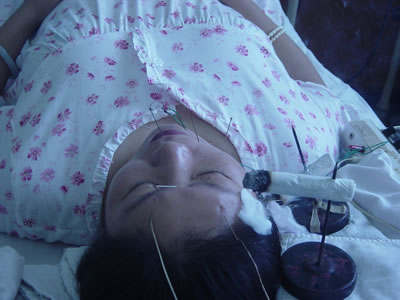A Medical Internship in China
Learning About Ancient and Modern Medicine
Article and photos by Lucy Hordern

Life on a Medical Campus
Sacred graffiti lined the path as we entered the campus gates. A Chinese student explained that the giant red calligraphy were quotes from an ancient medical text, blazoned so the students never forget about the subtleties
of yin and yang (terms to determine the state of balance within).
The path led past a large marble statue of Li Shi Zhen, China’s famous sixteenth century physician who wrote Ben Cao Gang Mu (Materia Medica). Li Shi Zhen wore the flowing robes of an Imperial Scholar and his
gaze urged one to do well. He presided over the campus herb garden which filled with students practicing tai qi every dawn. The shady Cypress trees and manicured Gardenia hedges around a pond made it my favorite place to revise my notes
during the afternoons.
I bought a cup of cooling Ju Hua (Chrysanthemum tea) to take back and savor quietly on my pokey verandah in the International students’ dormitory, tucked away in the rear corner of campus. 15,000 students attended Guangxi
Traditional Chinese Medicine University and although it was inspiring to see so many Chinese youth passionate about medicine, I found the
density of population energetically draining, and watching dragonflies perform their air show at the day’s end became the key to keeping my sanity.
The Internship
I took a 2-month internship with Professor Yi as the concluding semester and thrilling climax of my Bachelor of Health Science. This involved studying for four years at college in Australia, memorizing hundreds of acupuncture
points, point prescriptions, Traditional and Western diagnoses, anatomy, physiology, biochemistry, individual Chinese herbs, and complicated formulae. Traditional Chinese Medicine originated around two thousand years ago and is loosely based around
the theory of yin and yang.
There are four main branches of Traditional Chinese Medicine – 1) acupuncture, 2) massage, 3) herbal medicine, and 4) exercise therapy, such as T'ai
qi or Qi gong. I had studied a taste of all four branches, but took the internship hoping to take this learning to a deeper level. In the West, acupuncture
is often practiced in isolation and I looked forward to seeing all four branches working as a team.
Work in a Chinese Hospital
I glanced out the hospital window to see a haze of steam from the city’s breakfast baozi (steamed buns) mixed with the oppressive heat that comes with summer on the Tropic of Cancer and began my days’ work
at Nanning Number One Hospital. It was my honor to
work with Professor Yi, a skilful Traditional Chinese Medical practitioner, who busily treated Out-Patients from 8 a.m. — 11 a.m. every morning, six days a week.
Acupuncture as Practiced in the East
In the West, acupuncture is seen as alternative medicine, however in China it was refreshing to see that it is a normal, noisy, community event, with the patients chatting to one another as they lay side by side. Five beds
were laid out down each side of the room, rather like a dormitory, (clean) squat toilets were down the hall, and there was one sink without hot water in the corner. Patients began queuing for their treatments from 7.30 a.m. each morning, sipping
jasmine tea out of glass jars as they waited for us to open the door.
The Patients and the Doctors
‘I have pains in my heart,’ explained our first patient in bed one, pointing to her chest.
“Yi Laoshi,” another intern and I immediately called out to Professor Yi, who had begun treating his patient in bed five.
We decided this new patient was best seen by Professor Yi. With eccentric tufts of hair, and frequently displaying an impish grin, he exuded calm and humble wisdom. His success treating illness was reflected in his patients’ and
students’ adoration alike.
He felt the patient’s pulse, and checked her tongue to determine whether her condition was yin or yang in nature, internal or
external. In a few deft movements, needles were inserted into her hands, legs and feet with instructions to us for administering moxibustion and a complex herbal
prescription. We fluttered around arranging the moxa sticks which were made of compressed Artemesia leaves and lit close to the patient’s skin to help with blood
circulation.
Then we moved to bed two, who was a regular patient with sciatica. He received the same treatment daily and after a strong tuina massage, I inserted about twenty needles into the offending leg and buttock. He also
received moxibustion and strong electrodes were connected to several points as well to encourage circulation. Professor Yi came to check my work and continued to treat another patient. No comment was apparently a good sign, the other interns
reassured me. We continued in this way until lunch time every day.

The Role and Responsibilities of the Intern
Interns who pass ‘the test” are allowed to perform acupuncture on so-called easy patients, but the more challenging patients were referred to Professor Yi for specific diagnosis. “The test” meant inserting
very fine needles into acupuncture points. If the patient reported a strong sensation of qi (life force) one passed “the test.” I had practiced many hours in our
student clinic in Australia, and so was fairly confident and passed my test first go, thankfully. Other interns who did not pass simply continued observing, which was still immensely educational.
For all of us, many notes were hastily scribbled in a small booklet and tucked into the pocket of one’s White Coat in between patients. I did not want to miss a minute; however, our schedule proved quite tiring. I asked
Professor Yi how he kept going, but he just grinned and continued.
In-Patients were treated on level eight of the hospital and it was quite an eye opener for me to see such suffering. Patients here slept on rickety bamboo beds and had serious illnesses such as cancer.
Some were recovering from surgery, and acupuncture sped up the process significantly. We visited many stroke victims daily to facilitate their recovery from paralysis. In Australia, I had seen stroke victims confined to wheelchairs
and stuck in sanitary pads for life, but here stroke victims enjoyed 90% recovery rates, which I observed in awe over several months.
Watching an 85-year-old man move his fingers for the first time in weeks seemed miraculous. There were many cases like his. They had strong acupuncture twice daily and took bitter black herbal decoctions which were brewed
up in the bowels of the hospital, poured into thermoses and brought around to all the patients on a trolley. Although I was physically exhausted, visiting this part of the hospital filled me with ideas about the future of medicine. Here was a
working model of Eastern and Western Medicine working together in harmony with unbelievable results.
Rooftop Qi Gong
After the last patient, Professor Yi beckoned us to follow him up a dusty back stairwell. How could we possibly refuse? He took us to the roof of the hospital and wordlessly began to demonstrate Qi Gong (a gentle
form of exercise therapy). He wanted to share the secret of his boundless energy after all.
We fell in behind, copying his slow floating arm movements. I took a small step, shaking my fingertips as Professor Yi did. I felt light and timeless. He later explained it was Wild Goose style qi gong and
he practiced every morning to keep his qi strong
.
Herbal Field Trip
To celebrate the end of our internship, Professor Yi took us on an herb-gathering field trip into Nanning’s foothills. We were quite a sight for the pig and buffalo farmers, as the students each carried bright umbrellas
for shade and a plastic bag of snacks. Professor Yi wore a traditional cone hat, pick in hand, ready to dig up roots of unusual weeds growing in the rice paddies.
We scampered after him into muddy ditches to examine Lantana, which I learnt worked wonders applied externally for eczema. He ferreted through the undergrowth seeking out a special anti-cancer fern and made us nibble sweet
potato leaves to keep our liver functioning at its peak. We gasped at all the strange shaped leaves and flowers, glad to finally see the reality of all these names previously only read about in black and white. While we rested in a Bamboo grove,
enjoying a cool breeze, hard working villagers harvested sugar cane over the hill.
Returning to campus, I sat contemplating the statue of Li Shi Zhen for the last time, munching a baby apple from a roadside stall. It had been exciting to witness Traditional Chinese Medicine in its place of origin and appreciate
the pros and cons of Eastern and Western medicine. I saw first hand how the two can mutually support each other to provide the best healing environment for patients, and left with a feeling of optimism to attempt something like this back home.
|
For More Information
Guangxi University of China Medicine has
international student programs from an introductory level
up to Masters’ programs, including all English translation of materials, however I recommend studying basic Mandarin beforehand for ease of transition.
nanningchinaguangxi.com — is a helpful site for all information about Nanning city.
China Admissions — is a good place to start learning basic Mandarin before any adventure in China, as many universities offer online courses as well.
acupuncture.org.au — is a website which provides clear explanations regarding all aspects of Traditional Chinese Medicine.
I recommend anyone traveling in China, interested in Traditional Chinese Medicine, to visit the local hospital and ask for the acupuncture department, which is zhen jiu (pronounced jen jo) in Mandarin. They will give you a quality, low
cost treatment for anything from touteng (headaches) to laduzi (diarrhea).
|
Lucy Hordern runs a Traditional Chinese Medicine clinic in Brisbane, Australia. She has a Bachelor of Arts and Bachelor of Health Science and completed an Internship at Guangxi
Traditional Chinese Medical University, PRC. She studied and worked as an acupuncturist/herbalist at Nanning Number 1 and Number 2 Hospitals followed by a grand tour of China, Tibet, and
Nepal.
|
